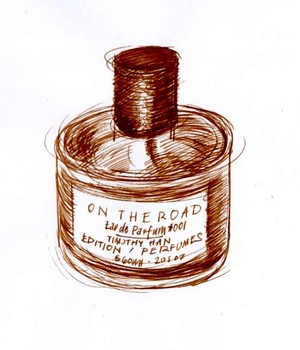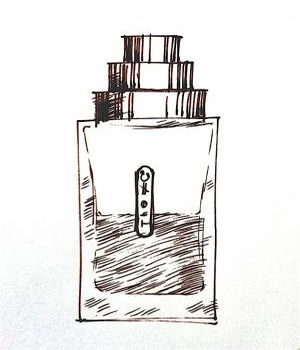Article Archive
Edition Perfumes
On the Road
26 November, 2015
 Since it was published in 1957, Jack Kerouac’s amphetamine-fuelled road-and-head-trip of a novel has inspired generations of would-be counter-culturalists to take off into the unknown, but until now, it has never inspired a perfume.
Since it was published in 1957, Jack Kerouac’s amphetamine-fuelled road-and-head-trip of a novel has inspired generations of would-be counter-culturalists to take off into the unknown, but until now, it has never inspired a perfume.
On the Road is only the second scent from East London-based Edition Perfumes, aka perfumer Timothy Han, but it follows in the literary footsteps of his first fragrance, She Came to Stay. Inspired by Simone de Beauvoir’s 1943 novel L’Invitée, She Came to Stay went on to be a best-seller for legendary London fashion boutique Browns.
Taking the plotline of Kerouac’s novel as its starting point, On the Road is one of those rare things in contemporary fragrance: a scent whose story unfolds on the skin – unlike so many recent perfumes, which continue to smell boringly identical from first spritz to final dreary gasp.
As Han describes his perfume, ‘it begins with smoky notes of benzoin and birch reminiscent of the hot asphalt and grittiness of New York City. Punctuated by forays into tobacco-filled bars where a new era in music is being defined by the jazz greats, our journey takes us through the openness of the dusty cornfields of a Mid-Western America and rises to the cedar forests of a Pacific Coast. The restlessness of the journey finally gives way to the optimism left by the fresh green fragrance of galbanum, citrus and bergamot.’
That is quite a lot to squeeze in to a 60ml bottle of perfume, but what we like about On the Road is that it really does develop in the hours after first spraying it on your wrist. Its initial burst of smoke and whisky gradually evolves into a very pleasing, long-lasting woody vetiver. It’s a fine piece of work, and all the more impressive given the quality of the design and packaging – though perhaps that’s less surprising once you learn that Han started his career as an assistant to John Galliano.
Though Han develops and makes his fragrances in his Dalston studio himself, he sees his work very much as a collaborative effort, and for On the Road he’s keen to mention hot young chefs Olia Hercules and Oliver Rowe, Hixter bartender James Randall and model Olivia Inge, without whom its launch, in Han’s words, ‘would have been a no-go’.
But perhaps the biggest shout should go out to the ebullient London artist Cedric Christie, whose photographs from a train trip he took from New Orleans to New York add an authentically On the Road-ish touch to the perfume boxes. Buyers get to choose from five different pictures, adding an extra layer of depth and desirability to the scent. All in all it’s a great launch, and I’m very much looking forward to Timothy Han’s next novel in a bottle.
Different Company
Osmanthus
8 July, 2014
 Much excitement in Weymouth, as the old Woolworth’s site has been transformed into a branch of T.K.Maxx. Even more excitement when, on our first visit, what should I pluck from the trashy mass-market scents you’d expect to find in a discount outlet but a brand-new bottle of Osmanthus by The Different Company.
Much excitement in Weymouth, as the old Woolworth’s site has been transformed into a branch of T.K.Maxx. Even more excitement when, on our first visit, what should I pluck from the trashy mass-market scents you’d expect to find in a discount outlet but a brand-new bottle of Osmanthus by The Different Company.
What a highly collectible perfume by a fairly obscure, high-end brand was doing in the Weymouth branch of T.K.Maxx I have no idea, but there it was, ours for the princely sum of £16.99 (recommended retail price €142).
Created by the much-admired perfumer Jean-Claude Ellena (now the in-house perfumer for Hermès) for the company he founded in 2000, Osmanthus gets an admiring review in the even more widely admired Perfumes: The Guide by Luca Turin and Tania Sanchez, and you can see why.
It’s a gentle, sweet but subtle scent, whose plush peachy centre is reminiscent of Guerlain’s timeless Mitsouko, though it seems to lack either Mitsouko’s strength of character or its mysterious staying-power. Yet Osmanthus has magic of its own, and its apparent evanescence on the skin proves something of a disappearing trick – for after putting a little on the back of my hand and noting that it didn’t seem to last very long, what should happen but that an hour or two later, as if from nowhere, its fresh, fruity scent would suddenly snap into focus again, almost as strong as when I first sprayed it on.
I’ve no idea how it’s done, or even whether the effect was intentional, but my guess is that it’s got something to do with the way Osmanthus’ peachiness bonds with the perfume’s other elements, some of which are a little surprising, like castoreum, a resinous compound extracted from beavers that has a leathery, animalic smell and is also found in Chanel’s wonderful Cuir de Russie.
Natural osmanthus, incidentally, is an attractive evergreen shrub which, in sheltered conditions, will grow to the size of a small tree. It grows wild in the Himalayas, China and Japan and was first introduced to European gardens in 1771, where it became known as Sweet Tea or Fragrant Olive. In the autumn it bears thousands of small but intensely fragrant white flowers, whose intoxicatingly sweet scent gives the plant its botanical name, Osmanthus fragrans.
Its fragrance, indeed, is remarkably powerful, as we discovered on an autumn visit to the enchanted garden of Brécy, near Bayeux. From the massively stepped levels of the formal gardens, which form a kind of vast single staircase up towards the Normandy sky, we recognised osmanthus’ heady scent a long time before we finally located its source, from a couple of dark columnar trees planted close against the south wall of the church, outside the gardens themselves.
Despite the sheer intensity of its fragrance, this is one of the only powerfully sweet scents I know that one can never smell enough (unlike, say, Madonna lilies, whose scent becomes overwhelming after a while): there’s a fresh lemony edge to osmanthus that makes it refreshing and intoxicating all at once. Enjoy Jean-Claude Ellena’s perfume by all means, but plant the tree wherever you can.